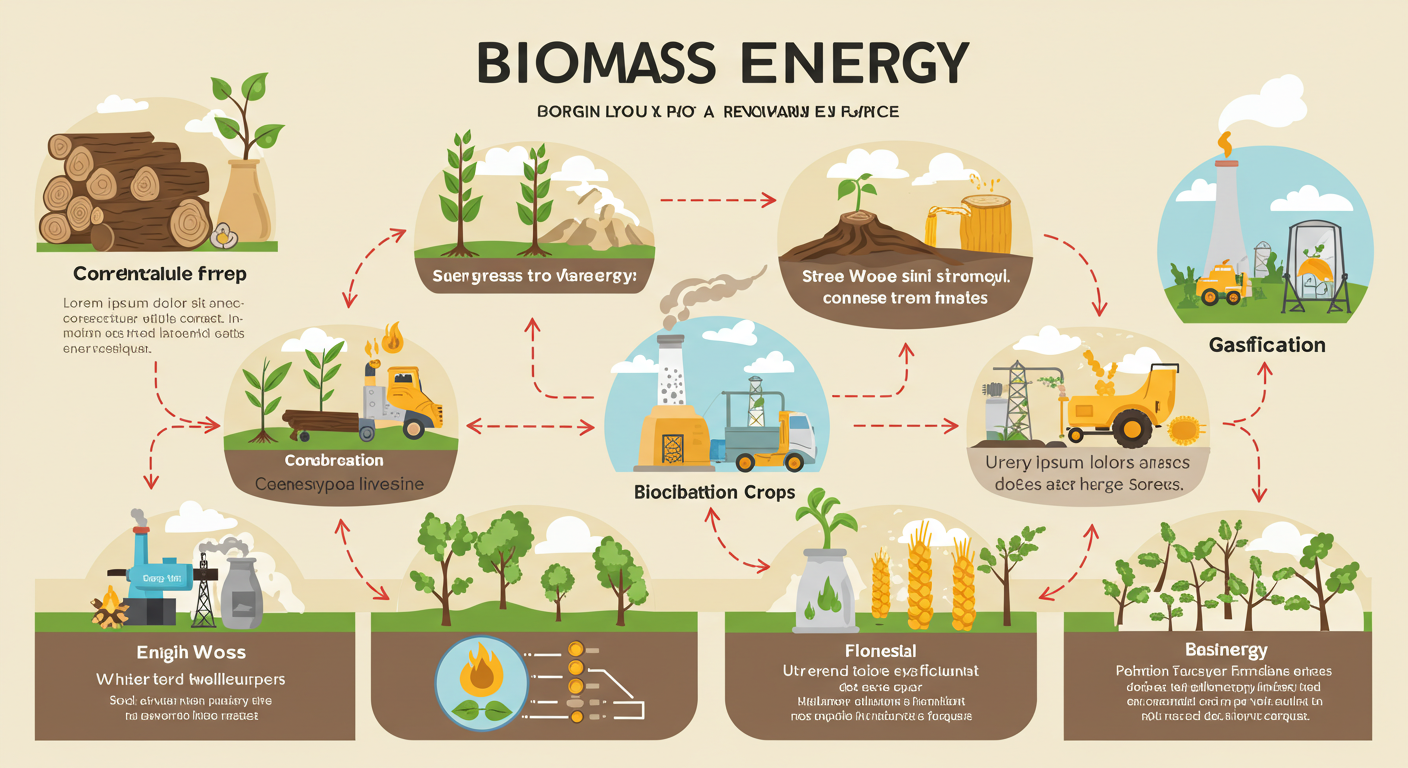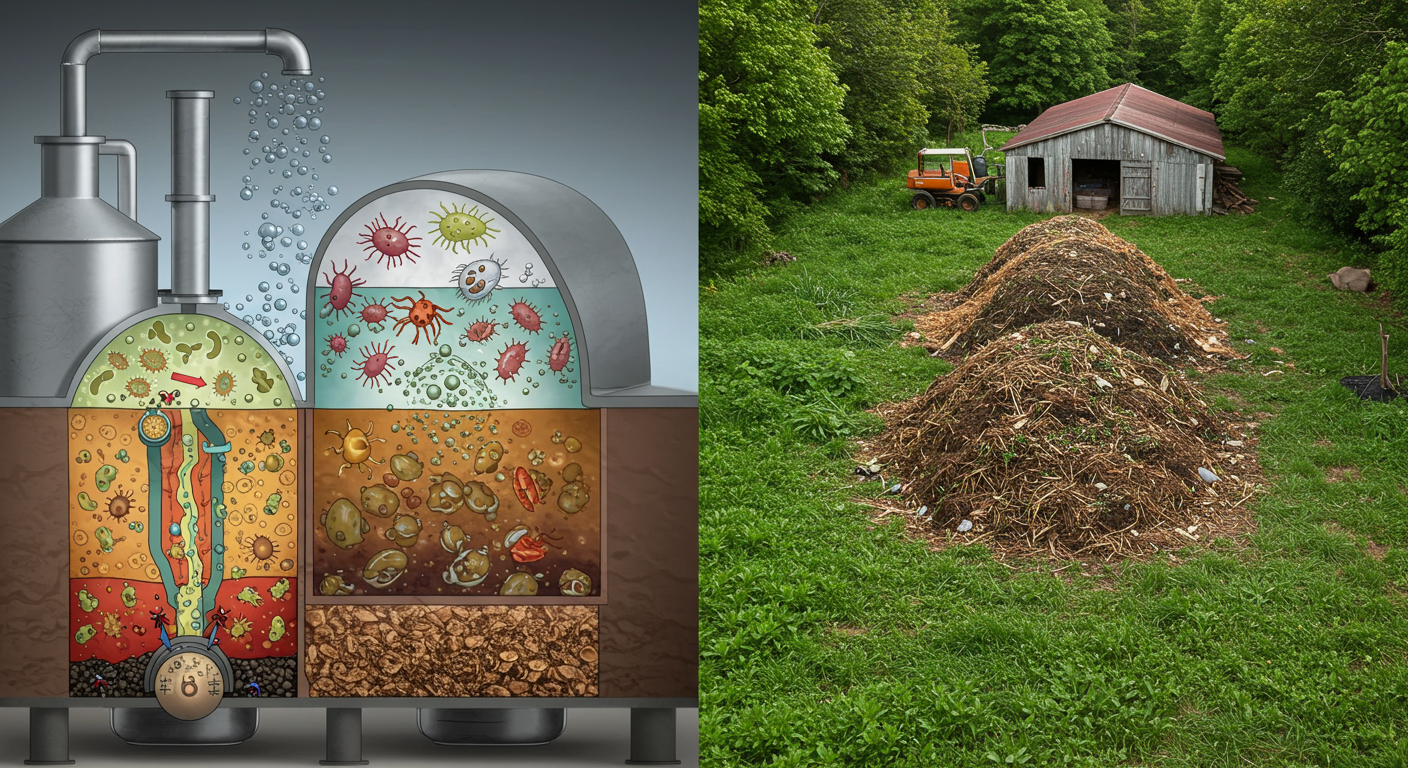Understanding Biomass: Nature’s Renewable Energy Source
Imagine being able to capture the energy stored in your farm’s waste—the manures, crop leftovers, wood chips, and more—to power your farm or even reduce fuel bills. That’s exactly what biomass energy is all about, and it’s one of nature’s most promising renewable energy sources. In this guide, we’ll take you on a practical, step-by-step journey that shows you how biomass works, what resources you already have, and how to set up your own system to harness nature’s power.
Whether you’ve heard about anaerobic digestion or just know that plant material can burn for heat, this article breaks everything down in an exciting yet simple way. We’ll dive into the science, share real-life examples from other farms, include handy tables, and give you actionable checklists so you can get started today!
1. Introduction: Turning Farm Waste into Energy
Farms are full of organic materials—manure from livestock, crop residues after harvest, pruned branches, and even wood waste from trees. Instead of seeing these as “waste” to be disposed of, think of them as untapped energy. Biomass energy uses these natural materials to create fuel, heat, or electricity.
Imagine saving money on fuel, reducing the disposal hassle of farm waste, and even improving your soil with byproducts—all at the same time. With biomass energy, you’re not just powering your operations; you’re making your farm more self-reliant and environmentally friendly.
Why Biomass?
- Renewable Energy: Biomass is regrown, and its energy is essentially stored sunlight waiting to be released.
- Cost-Effective: Using farm byproducts reduces the need to purchase expensive fuels.
- Eco-Friendly: It cuts down greenhouse gas emissions by harnessing energy that would otherwise go to waste.
- Dual Benefits: Some processes produce not only fuel but also nutrient-rich fertilizers to boost your crop yields.
2. What Exactly Is Biomass?
Simply put, biomass refers to any organic material—that is, anything derived from plants or animals—that contains stored energy from the sun. This includes:
- Crop Residues: Corn stover, wheat straw, rice husks.
- Animal Manure: From cows, pigs, chickens, and other livestock.
- Energy Crops: Specific plants grown for fuel, like switchgrass.
- Wood Waste: From pruning, wood chips, sawdust.
When you convert these materials, you release the stored energy to be used for heat, power, or even making biogas.
How Is Biomass Energy Produced?
There are several methods available to convert biomass into energy. Here’s a quick overview:
- Direct Combustion: Burning biomass directly to produce heat. Think of a wood stove or boiler.
- Anaerobic Digestion: Using bacteria in a sealed, oxygen-free tank to break down organic material. The process produces biogas, which can be burned for energy, and a nutrient-rich byproduct called digestate.
- Gasification: Heating biomass in a low-oxygen environment to produce syngas (a mixture of carbon monoxide, hydrogen, and methane), which can be used to generate electricity.
- Pelletizing: Compressing biomass into pellets that burn more efficiently.
These methods vary in technical demands and cost, but they all work on the same principle: releasing energy stored in organic matter. Let’s take a closer look.
3. Biomass Conversion: The Process, Step by Step
Here’s a simplified outline of one of the most common methods—anaerobic digestion—explained in everyday language:
- Collecting Your Feedstock:
- Gather your organic materials. On your farm, this could be manure from cows or pigs, crop residues, or even food scraps.
- Mix these with water to form a slurry. The water helps the tiny microorganisms move around and digest the waste.
- Sealed Digester System:
- Place the slurry into a sealed container called a digester. This container is airtight because oxygen would interfere with the process.
- Inside, naturally occurring bacteria break down the organic material.
- Producing Biogas and Digestate:
- As the bacteria digest the waste, they produce biogas—a mixture that’s mostly methane, a valuable fuel.
- The remaining material, called digestate, is rich in nutrients and can be used as a fertilizer on your fields.
- Harnessing the Energy:
- The biogas is collected through pipes and can be used for various applications—cooking, heating, or running generators.
- The digestate, when applied to your fields, boosts soil health and crop yields.
Here’s a fun table to summarize common biomass feedstocks you might already have on your farm:
| Feedstock | Source | Possible Uses/Benefits |
|---|---|---|
| Crop Residues | Corn stalks, straw | Can be burned directly for heat; used as mulch or converted via gasification. |
| Animal Manure | Cattle, pig, poultry | Great for anaerobic digestion; produces biogas and nutrient-rich digestate. |
| Wood Chips/Sawdust | Pruned branches, wood waste | Suitable for pelletizing; ideal for direct combustion in boilers. |
| Energy Crops | Switchgrass, miscanthus | Specifically grown for biomass energy; high energy content per unit. |
With this table, you can quickly assess what materials you have and what they could potentially do for your energy needs.
4. The Science Behind Biomass Energy: It’s Not Rocket Science!
While the word “science” might sound daunting, the process of turning biomass into energy is as natural as the changing of the seasons. Here’s a breakdown in plain language:
A. Stored Sunlight
- Photosynthesis at Work: Plants capture sunlight and convert it into energy as they grow. When you harvest these plants or use their leftovers, you’re also capturing a bit of that stored energy.
- Energy Storage: The organic materials on your farm—be it a field of leftover corn stalks or fresh manure—carry that stored energy. By converting biomass, you release this energy for practical use.
B. Role of Microorganisms
- The Tiny Helpers: In anaerobic digestion, bacteria are the unsung heroes. Without needing any fancy intervention, they break down organic material in a completely natural process.
- Simple Chemical Reactions: These tiny organisms convert the complex compounds found in organic matter into simpler forms, such as methane and carbon dioxide. It’s similar to cooking slowly over a campfire—only in a sealed tank!
C. Benefits Beyond Energy
- Double Duty: When you convert biomass, you’re not only producing energy; you’re also creating a fertilizer (digestate) that recycles the nutrients back to your soil. This means healthier crops without the extra expense of chemical fertilizers.
This blend of natural processes is not only effective but also beautifully simple once you see how it works.
5. Practical Steps for Implementing Biomass Energy on Your Farm
Now that you understand the basics and science behind biomass energy, how do you turn that theory into practice? Here’s a step-by-step plan with actionable tips.
Step 1: Evaluate Your Farm’s Resources
Action Points:
- Inventory Your Feedstock: List all the organic materials you produce regularly—manure, crop residues, pruned branches, etc. Estimate the quantities produced daily, weekly, or seasonally.
- Assess Consistency and Quality: Some materials might be available year-round, while others only during harvest. This will help you choose the right conversion method.
- Space and Infrastructure: Identify a suitable location on your farm where you can set up a digester or combustion unit. Most systems need to be in a sheltered area that isn’t exposed to extreme weather.
Step 2: Choose Your Biomass Energy Conversion Method
Here are a few options, each with its own set of advantages:
- Anaerobic Digestion: Ideal for farms with plenty of manure and wet organic waste. It produces biogas for energy and digestate for fertilizer.
- Direct Combustion: If you have wood waste or dense crop residues, burning them in a biomass boiler or furnace might be the easiest solution for heating.
- Gasification: For those interested in a slightly higher-tech option, gasification can convert biomass into a gas that powers generators. It might require more initial investment but can offer efficiency benefits.
Tip: Start small with a pilot project to see which method fits your farm’s needs best. It’s always exciting to experiment on a modest scale before going big!
Step 3: Build or Purchase Your System
Action Points:
- DIY or Professional Setup: Many farmers choose to build their own small anaerobic digesters using repurposed tanks or barrels. Others might prefer to invest in a ready-made system from local suppliers.
- Gather Equipment: For anaerobic digestion, you’ll need:
- A sealed tank or digester.
- Piping for gas collection.
- Monitoring tools like a thermometer and a pH meter.
- Safety features to ensure no leaks occur.
For combustion systems:
- Biomass boilers or stoves.
- Fuel storage and feeding systems.
- Maintenance tools for regular cleaning.
- Plan Your Layout: Draw a simple diagram of your system layout. Visual planning can help you avoid mistakes during installation and ensure everything is within easy reach.
Step 4: Start Feeding Your System
Action Points:
- Prepare the Feedstock: Mix your organic materials with water (if you’re using anaerobic digestion) to create a consistent slurry. For combustion, ensure the biomass is dry and properly sized (for instance, chipped or pelletized).
- Maintain a Feeding Schedule: Regular feeding is key to a constant energy output. Keep a log or checklist to record how much you feed in daily or weekly and note any changes in gas production or heat output.
Step 5: Monitor, Maintain, and Optimize
Action Points:
- Check the Parameters: For digesters, keep an eye on the temperature and acidity (pH) inside the tank. Aim for a stable environment—typically between 30–40°C (86–104°F).
- Regular Inspections: Walk around your system daily at first, then on a routine schedule. Look for leaks, blockages, or any abnormal changes in output.
- Keep Detailed Logs: Write down your observations. Over time, you’ll learn what factors affect your system’s performance and how to optimize your feedstock mix.
- Adjust as Needed: If you see a drop in gas production or heat, it might be time to alter the mix of materials or improve insulation. Small tweaks can make a big difference.
6. Economic and Environmental Benefits at a Glance
To keep things exciting, let’s review the key benefits in a quick-reference table:
| Benefit | What It Means for Your Farm |
|---|---|
| Cost Savings | Reduce fuel bills and fertilizer costs by using what you already have. |
| Energy Independence | Produce your own heating and power, reducing reliance on external supplies. |
| Improved Soil Fertility | Use digestate as natural fertilizer to boost crop yields. |
| Environmental Stewardship | Lower greenhouse gas emissions; show your commitment to a greener future. |
| Community Impact | Share surplus energy or fertilizer with neighbors and local cooperatives. |
Using these benefits as a guide, biomass energy isn’t just an investment in your farm—it’s an investment in a sustainable future for both you and the environment.
7. Real-Life Success Stories: Farmers Who Made the Leap
Nothing excites like hearing success stories from fellow farmers. Here are two examples that might spark your interest.
Example 1: Farmer Tom’s Anaerobic Digester
Background: Farmer Tom had been battling high energy bills and a mountain of manure from his cattle. Inspired by neighbors who had bravely experimented with renewable energy, he decided to try a small pilot anaerobic digester.
What Tom Did:
- Built a digester using a repurposed water tank.
- Carefully mixed manure with water to create the ideal slurry.
- Monitored the system daily, gradually scaling up the feedstock as production stabilized.
Results:
- Within weeks, Tom produced enough biogas to heat his barn during chilly evenings.
- The digestate improved his field’s soil, leading to better crop yields.
- Today, Tom is looking into expanding his system, saving money every month on fuel and fertilizer.
Example 2: Farmer Rita’s Biomass Boiler
Background: Farmer Rita had plenty of straw and wood chips left over from harvest. Instead of burning conventional fuel for her greenhouse’s heating, she investigated biomass boilers.
What Rita Did:
- Installed a biomass boiler suited to her scale of farming.
- Organized wood chips and straw into a regular supply chain.
- Initiated a daily checkup routine to ensure efficient burning and minimal downtime.
Results:
- Rita dramatically cut her heating costs and even sold surplus heat to a nearby farm cooperative.
- Her commitment to renewable energy also attracted local grants, enabling further sustainable investments on her property.
These stories prove that no matter the size or type of your farm, there’s an option out there that can transform waste into wealth.
8. Troubleshooting and Overcoming Common Challenges
All systems come with their challenges. Here are some common issues and what you can do about them:
Issue 1: Inconsistent Feedstock
- Challenge: Seasonal variations (e.g., too much crop residue during harvest and less at other times) can affect energy production.
- Solution:
- Maintain a diverse mix of feedstock.
- Consider supplementing with purchased energy crops during lean periods.
Issue 2: Temperature Fluctuations
- Challenge: Colder weather can slow the digestion process.
- Solution:
- Insulate your digester or install a mild heating system.
- Position the system in a sheltered area to minimize cold exposure.
Issue 3: System Maintenance
- Challenge: Regular checks and upkeep can seem overwhelming.
- Solution:
- Create a simple maintenance checklist.
- Involve family members or farmhands; turn maintenance into a community effort.
Issue 4: Upfront Investment
- Challenge: Starting a biomass system can be costly.
- Solution:
- Look into government grants and local support programs.
- Start small with a pilot project to build confidence and demonstrate benefits before scaling up.
9. Looking Forward: The Future of Biomass Energy on Your Farm
Embracing biomass isn’t just about immediate energy savings—it’s about preparing for a sustainable future. Here are some exciting possibilities to think about:
- Energy Resilience: As fuel prices soar and are subject to market volatility, having your own renewable energy source can safeguard your farm’s operations.
- Community Collaboration: Farms pooling resources to create a community biomass system can lead to shared benefits, such as energy cooperatives or local energy grids.
- Innovation in Technology: New advancements continuously make biomass systems more efficient and easier to manage, promising even greater returns on your early investments.
- Environmental Leadership: By reducing reliance on fossil fuels and managing waste wisely, you become a role model for sustainable farming practices—setting your farm apart in a competitive industry.
10. Your Action Plan: Ready to Dive In?
Here’s a quick checklist to get you started on implementing biomass energy on your farm:
- Survey Your Farm Resources:
- Inventory available organic materials.
- Assess consistency throughout the year.
- Identify a suitable location for your system.
- Choose Your Conversion Method:
- Decide if you want to start with anaerobic digestion, direct combustion, or gasification.
- Consider starting small with a pilot project.
- Plan Your Setup:
- Draw a simple layout of your system.
- List all equipment needed (tanks, pipes, boilers, monitoring tools).
- Research local suppliers and potential financial assistance.
- Implement and Monitor:
- Set up your system and begin controlled feeding of your biomass.
- Maintain a daily log of performance metrics (temperature, energy output, feedstock amounts).
- Adjust your process based on observed performance.
- Review and Grow:
- After a trial period, review your savings and system reliability.
- Consider expanding your system gradually.
- Join local farmer groups to keep learning and sharing.
11. Wrapping It Up: Embrace Nature’s Energy Today!
Biomass is nature’s way of storing energy, and your farm is brimming with untapped potential. By converting manure, crop residues, and wood waste into renewable energy, you’re not only saving money—you’re securing energy independence, improving your soil, and contributing to a healthier environment.
The steps are practical: evaluate your resources, set up a simple pilot project, monitor the process, and gradually expand. Each step forward is a win for your farm and for Mother Nature.
Remember, the journey toward renewable energy is exciting and full of opportunities. It’s a chance to transform what once was considered “waste” into something that fuels your farm’s operations and conserves resources for future generations.
So why wait? Take a look around your farm today—inspect your piles of crop residues, think about the manure that could be more than just a disposal headache, and envision a future where all of it powers your operations. The power of nature is in your hands. Harness it, and let your farm lead the way to a greener, more sustainable tomorrow.
Final Thoughts:
Biomass is not just another buzzword; it’s a practical, proven way to turn the everyday byproducts of farming into a thriving, renewable energy source. By taking small, confident steps today, you’re investing not only in your bottom line but in the long-term health of your community and the environment.
Embrace the challenge, experiment with the possibilities, and share your successes with fellow farmers. When nature provides, it’s up to us to use it wisely—and there’s no better time than now!
Happy farming, and here’s to a future powered by nature’s own energy!
Feel free to leave comments, share your experiences, and reach out to local agricultural extension services for tailored advice. Every innovation on your farm is a step toward a brighter, more sustainable future for all.





This website was… how do I say it? Relevant!! Finally I’ve found something
that helped me. Appreciate it!